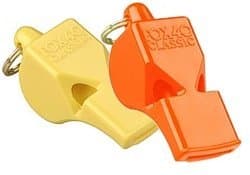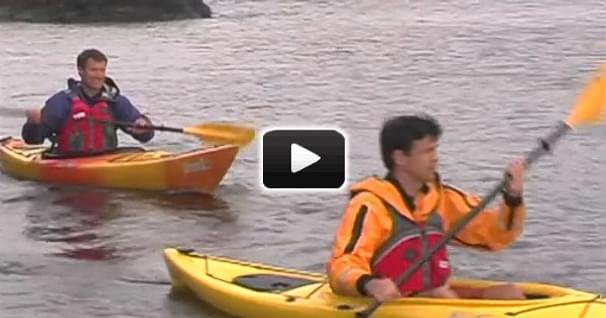The Whistle In Kayaking
A couple of months ago I had the pleasure to observe one of the local kayaking instructors for a couple of days. During one of the breaks, I was sitting around with the students and I noticed the all to familiar sight of the combat ready knife and the safety whistle hanging on the main zipper of the PFD (See USK article, "Combat Ready Knife" for my thoughts about knives on PFD's). I wish to focus this article on the use, expectations, reliability and storage of your whistle when paddling.

First I want to be very clear that I am 100% in favor of every PFD having a whistle attached to it. I know from experience that a whistle carries a lot farther than your voice. It is also a fact that your voice will give out a lot sooner than your whistle. However there are a number of concerns I have about whistles all derived from personal experiences.
I think there is a false expectation of how far the sound of a whistle can travel. During a navigation clinic off of Martha Vineyard we had a head wind on the return compass run. The group was getting farther apart as we were approaching shore, which is very common (see USK article, "Run Back To The Barn Attitude"). I asked two of the folks at the tail end of the group to capsize and signal the front of the group for assistance. The point of the capsize exercise was to show the entire group the benefits of staying together. Again, we were going into a head wind. The two in the water only had whistles. They didn't even try shouting, because they knew the paddlers in front were too far away. After blowing their whistles their amazement was apparent when the front group did not hear them. The distance was no more than 200 yards.
We had to send a paddler ahead to get closer to the group so they could hear a whistle. Due to the wind, those in front never heard the initial whistles. The fact that none of the lead group never turned around on regular basis to check on those behind is a discussion topic for another time. I often tell groups to test their whistles on calm days and windy days to see how far the whistle carries with and against the wind. I suggest you do the same, because just having a whistle doesn’t mean you are going to be heard. That is why a good signaling kit contains other options (see USK article, "Signaling"). As I said at the beginning, I think whistles are a necessity, but they do have limitations. Knowing those limitations is important. It is your responsibility to find the range of your whistle if you wish to depend on that whistle.
50 years of lightweight, maneuverable, high-performing kayaks.
Check out this interview with Tom Keane, Eddyline Kayaks Co-Owner, on their journey!
My next concern is where to store the whistle. Part of knowing where to store it is also dependent on the size of your whistle and the features on your PFD. Since there are so many different PFD's on the market I am not going to tell you the best place to store your whistle. I will tell you where and I store mine and why. I will also give you criteria to consider when picking the storage location for your whistle.
Personally I prefer a small whistle than a large one. I suggest you get a whistle that DOES NOT have a little ball in it. Those balls can get stuck in the chamber and cause the whistle to malfunction, especially in salt water. My very first metal whistle corroded and can be rough on your mouth and your teeth. Plastic ones seem to be more user friendly. I personally use a "Fox 40". I store the whistle in the pocket of my PFD on a small lanyard so it can reach my mouth.
I originally stored my whistle attached to the front zipper of my PFD. I thought this was a great location, because it was also a zipper pull and the whistle could reach my mouth when the PFD was zipped up. As a side note, when I started kayaking there were no pockets on our PFD's. Even if there were, the zipper seemed like a great location. After wearing the whistle on the zipper for four or five years I had a very interesting incident on the South Fork of the American River when I was whitewater kayaking. We were starting our run at Chili Bar (if my memory correctly serves me) and we decided to play in a small play hole near the put in. During one of my turns in the hole I got flipped over and was trying to roll up and I felt restricted. I realized I had my PFD open and around my shoulders. I managed to roll up and went off into the eddy to zip up my PFD and curse myself for not remembering to do so when I got on the river. I couldn’t believe I was so stupid as to forget to zip up my PFD.
When it was my turn, I went back into the play hole. Eventually I got flipped again. I started to feel my PFD on my shoulders again. I opened my eyes to see the turbulent water and bubbles actually pulling on the whistle. Since I was upside down the whistle was trying to float to the surface and the turbulent water was pulling it there. This whistle zipper pull was opening my PFD as I stayed upside down. I rolled up and headed for the eddy. Took the whistle off of the zipper and never put anything on the zipper of my PFD again. I share this story with anyone I see with their whistle on their zipper.
Over the years I have seen sea kayakers with whistles on the front of their PFD's get caught on deck lines, cockpit coamings and deck gear as they try to climb on their boats during recovery exercises. I think having anything on your PFD that can get snagged during recoveries is a potential danger. Your whistle is supposed to be a safety item NOT a liability.
I wish PFD manufacturers would make very small whistle pockets with a hook inside so you could easily store your whistle on a short cord and have it accessible when you need it. If you put it in a big pocket it can get tangled up with the other items in the pocket. Until whistle pockets are a reality (I doubt if the ever will happen) you need to choose your personal whistle storage location. Wherever you store it, make sure you can get to it in an emergency. I suggest you get one that will work without maintenance.
I believe whistles are a necessity, but you need to know their range and limitations. You should have more than one signaling devise when you go out. Don't fall into a false sense of security that having a whistle will be the "end all" in case you need help. Again, store it where it is an asset not a liability.
Wayne Horodowich, founder of The University of Sea Kayaking (USK), writes monthly articles for the USK web site. In addition, Wayne has produced the popular "In Depth" Instructional Video Series for Sea Kayaking.
Related Articles
As the days get shorter and the weather gets colder, it becomes harder to get out and paddle and easier…
I'm sure you'll be happy to hear that kayaking is a remarkably safe sport. In fact, compared to most…
Hi, I'm Robert Stehlik with Blue Planet Surf. I wanted to talk a little bit about moving around on the…




